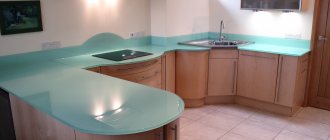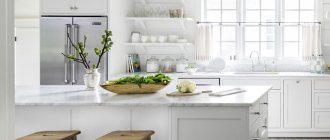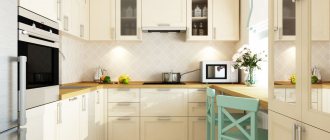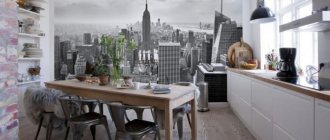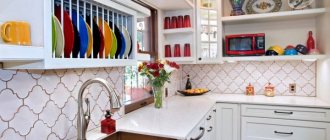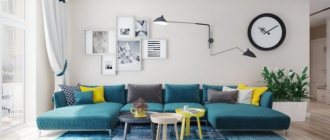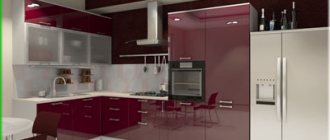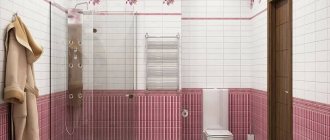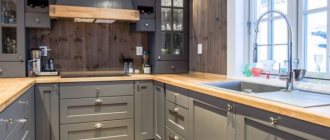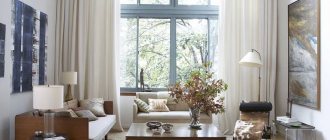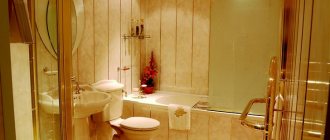In recent years, many new finishing materials have appeared on the market, which today can surprise few people. They were able to amaze consumers with their bright decorative properties, but this led to the fact that people began to pay less attention to maintaining the environment and hygiene in the kitchen.
When it comes to decorating an apartment with your own hands, for many craftsmen such a criterion as ease of execution becomes very important.
Naturally, old technologies are inferior to new materials in the sense that they significantly increase the cost of finishing work. Unfortunately, many people today believe that paint and ceramic tiles are the only viable options for finishing surfaces in the home. However, manufacturers have an answer to changing needs. Today they offer kitchen wall panels for kitchen decoration.
They prove their superiority with impressive performance characteristics, in which many traditional materials cannot compete with them on equal terms. In addition, they offer wider possibilities for decorating the interior of the kitchen space. With the help of kitchen wall panels it is very easy to give the room an individual appearance that will bring aesthetic pleasure to the owner and all family members during every minute spent in the kitchen.
What are PVC panels
PVC kitchen panel is a material based on polyvinyl chloride. The material is high quality and completely safe. PVC is resistant to moisture and heat. The material is very simple.
And thanks to its light weight, it is very easy to install. Thanks to the longitudinal honeycomb structure, the plastic has an internal cavity, which improves heat and sound insulation. And if you use wall panels in your kitchen interior, you can quickly and radically transform the room.
PVC panels vary in shape, size and method of processing the decorative layer
Panels are considered one of the most suitable materials. They can be divided according to the type of material that is taken as a basis. Plastic models have advantages and disadvantages that must be taken into account when choosing.
The average service life of plastic panels is 10 years. In reality, products can last much longer - it all depends on operating conditions
Made from MDF, laminated chipboard or plywood
Panels, for the production of which the method of pressing wood material is used, can easily be installed in the kitchen, since there is protection from moisture - lamination, especially double-sided. These products include MDF panels for the kitchen, products made from chipboard and plywood.
In the kitchen, panels made of MDF and plywood are most often used, while the second has the best moisture resistance. Products made from chipboard, even with double-sided lamination, have lower mechanical strength and are not resistant to changes in temperature and humidity.
Laminated chipboard in the kitchen
When choosing these panels for the kitchen, you should also take into account their low fire resistance, so it is better not to use them to decorate an apron near a gas stove. For rooms equipped with electric stoves, they are quite a suitable option, especially since they are not inferior in appearance to plastic ones: the applied lamination layer can imitate any pattern, so they will organically fit into any design.
Among the advantages, it should be noted that it has fairly high mechanical strength and ease of maintenance using non-abrasive detergents.
What types of panels are there?
Before choosing the ideal panels for your kitchen, let's find out the types and classes. Depending on why you need panels, you will select the optimal size, width and type of coating.
- Rail. Such products are similar to lining and, as a rule, are produced with a maximum width of 12.5 cm and a length of 3 meters. Most often, such models are made in one color. They are chosen to replace expensive ceramic tiles. Rack and pinion models will cost an order of magnitude cheaper. In the photo below you can see an example of finishing a kitchen ceiling with slatted models.
- Tile panels. They are produced in the form of plastic tiles in two sizes: 30x30 and 98x98 centimeters. If you want a mosaic on the wall, tile covering is a great solution. With its help you can decorate both part of the wall and the apron area. The mosaic can be plain or decorated with different patterns. It can also be a modular system, which includes tiles with different patterns. You can combine and arrange images. The modular system is suitable for kitchens connected to the dining room.
- Sheet panels are the largest panels for the kitchen and are considered a universal option. You can use them to cover an entire space or decorate your workspace. Sheet metal panels can be up to 4 meters long and 2 meters wide. In the photo below, see different ways to use such products.
- Composite. This type of panel deserves special mention. Of course, they are not used so often for the kitchen and are usually in demand in private homes. These are sandwich panels consisting of several layers. Their main advantage is that they can provide good heat and sound insulation. But they have a drawback: composite products are not so rich in color options.
The latter type of panels can successfully replace tiles in all respects, both in terms of durability and finishing. It is clear that slab models are best suited for cladding all walls. Their large size makes them easier and faster to install. In addition, such plastic products are distinguished by a variety of textures and colors.
Sheet metal panels can have a floral pattern, a brick pattern, or decorative stone. But to decorate a kitchen apron, it is better to choose tiled models. Instead of wallpaper, sheet panels are often chosen for the kitchen - they have a similar cost, but plastic is a more durable material.
Wood-effect kitchen apron
If you want a wooden panel, but are not willing to spend a lot on it, the best solution is an MDF panel. It exactly imitates wood texture and is inexpensive. Good MDF panels are practically indistinguishable from their natural wood counterparts.
Technical nuances when choosing PVC panels
To choose panels that will last a long time, you need to pay attention to their technical characteristics and overall quality:
- Thickness. Of course, no plastic panel will be very thick - its purpose does not require this. But still, more or less durable products start from two and a half millimeters. Anything thinner belongs to the cheap segment and breaks easily.
- Number of fastenings. The rigidity of the panel is given by special ribs on which the main surface rests. The more there are, the less likely it is that the plastic will crack due to careless movement. But the more ribs, the more expensive the product.
- Color. It should be uniform, there should be no cracks, chips or small defects on the panel. No colored spots, swelling or depressions. All such little things may indicate that the panel will very quickly lose its attractive appearance.
- Weight. The stronger the panel, the more it weighs, this is logical, since a lot of additional reinforcement is added. To see which of two panels of the same size will be stronger, simply lift them up.
- Mutual compatibility. There is always the same plastic in one batch: it was produced under the same conditions, packaged and stored under the same conditions. Therefore, you should buy products from one batch. The same product, but from a different batch, may differ slightly in color.
- Certificates. A serious seller can always provide documents for the goods, if available. They indicate the manufacturer, materials, warranty period, and stamped compliance with GOST. In the absence of a quality certificate, it is better to refuse the purchase - such plastic is unreliable and can be harmful to health.
When checking the appearance of the panels, take the canvas from the middle of the package. If a seller wants to sell a defective product, the illiquid stock will most likely lie in the depths.
Top three – from MDF to plastic
If you are faced with the choice of covering for kitchen walls for the first time, the first question that will arise is what types of wall panels are there? All products can be roughly divided into several types: glass, plastic, chipboard and MDF, as well as natural materials. Each type has its own advantages and disadvantages. Let's look at the top three, which are most often chosen for decorating and protecting kitchen walls.
MDF panels
Let’s say right away that you should choose laminated MDF as wall panels.
This can be a product where only the front side is covered or a model with two laminated surfaces. The last option is better, more reliable, but more expensive. Laminated MDF, unlike regular sheet metal, repels dirt and is easier to clean. This material has several other advantages:
Such panels can be installed quite easily in the kitchen yourself. Below you can see photos of laminated MDF wall panels.
As for the disadvantages , it is worth saying that the material can easily ignite and does not tolerate constant moisture. Although the sheet is coated on both sides with a protective coating, it can become deformed from exposure to moisture.
If you need to wash off grease from laminated MDF, it is better to use soft sponges and brushes.
Plastic products
The most popular option for covering kitchen walls. Its main advantages are versatility and affordable cost. If ten years ago plastic was used most often in government agencies, today this material has become more versatile due to the appearance of more colors and textures. What's good about plastic:
Another advantage worth noting is the ease of installation.
When tiles require laying skills and wall preparation, plastic can be installed in a few hours. Modern kitchen panels made of plastic can be not only the standard snow-white color, but also have a glossy shine, textured patterns and eye-catching colors. In the photo below you can look at the interior of the kitchen, where the walls are lined with plastic panels. As for the disadvantages , plastic is “afraid” of high temperatures, so such products should not be placed near a gas stove. Plastic can also be scratched or damaged, especially if washed and cleaned with hard brushes.
Laminated chipboard
The most budget option for decorating kitchen walls. Compared to ordinary chipboard, laminated panels can be thoroughly washed and cleaned - they do not deform and retain their shine. All this is due to the fact that such panels have a laminated front side, which acts as both a protective shield and a decorative finish. The main advantage of laminated chipboard is its low price. We can say that this option for the kitchen combines accessibility and practicality. In the next photo you can see what laminated chipboard looks like in the kitchen interior.
This material also has a couple of disadvantages.
The first is the fear of temperature changes. Of course, if you are choosing panels for a kitchen in a multi-storey building, you should not be afraid of this drawback, but for a kitchen in a private house or a kitchen-veranda it is better to choose another option.
The second is the short service life. While tiles can serve you for decades, laminated chipboard panels can become deformed when exposed to moisture or steam. If you frequently wash and clean kitchen panels with chemicals, they will lose their visual appeal.
How to choose the pattern and color of a PVC panel?
The choice of color, texture and variety of prints on panels is comparable only to wallpaper - there are options on the market for every taste. Thanks to this, you can bring any interesting ideas to life.
- Monochrome. They are similar to painted walls, it is practical and elegant.
- With imitation of natural material. The more natural the print looks, the better the result will be.
- With a repeating motif. The same pattern on all boards, which when assembled imitates tiles or other finishes.
- With a composite pattern. Several elements form a single image: landscape, still life, artistic canvas.
The photo shows a plastic apron with imitation wood
The choice of plastic panels for the kitchen depends on the size of the room. Small patterns, light colors for small kitchens, large prints and dark colors for spacious ones. Glossy materials make a room appear larger; matte materials do not affect the visual perception of size.
And on the style: imitation metal suits minimalism and high-tech, brickwork suits loft and scandi styles, natural wood suits classics.
The photo shows PVC sheets with a brick pattern
White PVC panels in the kitchen interior
White is one of the most universal colors, so it will fit well into any interior and kitchen style. In addition, it is easy to combine with bright colors of furniture.
For a classic white backsplash, use ceramic tiles. A more interesting option is to imitate a brick wall, especially if the work area is equipped with additional lighting.
Black wall panels
A black panel in the kitchen always looks discreet and elegant. If you add light furniture to the kitchen space, it will create a contrast with the panel. This will make the dark color look less gloomy and dull.
Maybe you want a dark kitchen, but the size of the room doesn't allow it. In this case, keep the base color white and the backsplash and workspace black. With this solution you will maintain a sense of space and satisfy your needs.
Blue wall panels for the kitchen
Shades of blue are calm and peaceful. These are cool shades, so their use should be limited to rooms where the windows do not face the sun, or dilute them with warm colors.
For example, add beige, milky, cream, sand or wood - these combinations are most beneficial for all shades of blue.
Yellow wall panels for the kitchen
A cheerful palette is very relevant for areas with long winters - it neutralizes the lack of sunlight. At the same time, the yellow range is varied - choose the tone of lemon, mustard, canary, vanilla, banana, dandelion, based on your taste, parameters and style of the room.
Brick wall panels for kitchens
Kitchen decoration with brick panels remains one of the most popular. Brick is suitable for any design solution.
Brick, including decorative brick, absorbs light. It is best used in well-lit rooms.
Gray color in kitchen design
A gray kitchen apron looks great in contrasting designs. If your countertop is green, yellow, red or blue, choose shades of gray for the panels, ranging from light to dark.
Panels with photo printing
The main advantages of this solution are a large selection of materials and the ability to create an individual model. All you have to do is choose the method of applying the image:
- onto the film, after which it will be glued to the selected material;
- applying a pattern to the base material.
In the second case, the image will be brighter and the paint will not peel off.
Wood panels
They allow you to create a variety of designs and imitate expensive types of wood. This solution costs the buyer much less, and the panel itself is suitable for most styles.
Under porcelain stoneware
A porcelain stoneware wall panel looks great in a classic interior with a lot of furniture and appliances. Using panels of a light shade and with a pattern, you can imitate the Provencal style in the kitchen.
Dark panels are perfect for a modern style. They can be used intelligently in small kitchens and studios.
Marbled
Imitation of white marble looks elegant and noble. Marble is easier to integrate into a classic style, and to reflect the light beautifully, add additional lighting sources.
Imitation of black marble is created using artificial stone panels. It will look harmonious in an interior designed in a modern style.
Application options in the kitchen
Finishing the kitchen with panels can affect all surfaces or one of them. Most often, plastic panels are used to decorate the ceiling, walls and apron.
Repairing the kitchen ceiling with plastic strips. Ceiling finishing is done with special lamellas - they differ from wall ones in less strength and light weight. They must be handled with the utmost care; there is a high risk of damaging the material during installation. Advantages of a panel ceiling:
- does not deform even after a flood;
- withstands any temperature changes;
- does not require surface preparation;
- hides wiring and communications.
Most often, plain PVC panels are used, but to create an original interior, you can decorate the ceiling with printed strips.
The photo shows the ceiling finishing with PVC panels
Decorating the walls in the kitchen with panels. Finishing materials for wall decoration are stronger and heavier. The design of the walls in the kitchen will not look cheap if you purchase high-quality slats. Plain planks or those with imitation stone/wood texture look advantageous. For walls in the kitchen, choose seamless structures, otherwise dust and dirt will accumulate in small spaces, which is almost impossible to clean.
Horizontal wall decoration in the kitchen will expand the room, and vertical installation will visually raise the ceiling.
The photo shows horizontal installation of panels
Installation on a kitchen apron. The area that suffers the most during kitchen work is above the countertop. PVC panels for the apron should:
- withstand high temperatures (170C);
- have a laminated surface;
- mounted without seams;
- go behind kitchen cabinets from above and below.
If your apartment has a gas stove, give up the idea of finishing the apron with panels or additionally protect the cooking area. Even heat-resistant slats are afraid of open fire and can melt.
One way or another, decorating a kitchen apron with PVC panels is the most budget-friendly option that allows you to bring an unusual design to life. From bright colors to paintings depicting urban motifs, landscapes or still lifes.
The photo shows plastic sheets for mosaics
Pros and cons of PVC
The use of plastic in the interior is gradually being reduced to a minimum. Due to the trend towards respecting the environment, all non-natural materials are losing popularity. It is generally accepted that plastic coating is a relic of the past and is only suitable in cases where there is a need to save money. But this finish also has its advantages.
pros
- Firstly, the price - on average, PVC is 2-3 times cheaper than tiles and even wallpaper.
- Installation takes minimal time. When laying a tiled apron, taking into account the preparatory work, it takes a day or more.
- Durability. With proper care, this coating will last for decades.
- Another plus is moisture resistance and ease of care. There are no pores on the surface of the smooth material, so you don’t have to worry about the spread of mold; it can be easily cleaned of dust and dirt with a regular damp cloth.
- This coating has good sound and heat insulation properties. You can use it to decorate a cold side or a wall adjacent to noisy neighbors.
- Fire safety. Polyvinyl chloride is a non-flammable material; if it catches fire, it goes out immediately.
Minuses
- Polyvinyl chloride is non-toxic, but, like any plastic, it is not an environmentally friendly material, since its decomposition period is hundreds of years.
- High degree of deformability. The plastic coating is easily subject to mechanical damage - impacts, cuts.
- This material does not burn, but it melts at high temperatures, which is also bad, especially when it comes to finishing the cooking area.
- Manufacturers guarantee durability, but bright colors and designs fade over time and lose their original appearance.
- With such a finish it will not be easy to create a modern design.
Glass kitchen apron
Glass panels look modern and original. Their main advantage is the absence of joints on the surface, which makes the apron hygienic. There are no seams - no dirt accumulates, which means caring for the panels will not cause problems. This apron opens up many possibilities for interior decoration. For example, behind the glass there may be your photographs, favorite recipes, photo wallpapers and much more - it all depends on the owner’s imagination. This unusual method will help you save money while getting a beautifully designed apron. The glass itself is often decorated. You can apply a stained glass pattern to it yourself, or order a ready-made product, paint it with acrylic paints, or purchase an apron with a decorative film attached.
Don't worry about the panel breaking. Such aprons are made of special tempered glass, which has increased strength and is resistant to heavy loads. For additional reliability, the products are covered with a protective film. If the load is exceeded, the glass breaks like a “web” - the fragments remain on the film, so it is completely safe.
Disadvantages of glass panels:
- When ordering, you need to accurately determine the size of the product. If the panel does not fit, it will not be possible to reduce it - the glass cannot be cut.
- If the glass is transparent, the surface must be thoroughly cleaned of dirt so that the apron looks presentable.
- Relatively high price.
Features of using plastic panels
The use of PVC in the kitchen has its own characteristics that must be taken into account if you decide to give them preference.
For interior walls and splashbacks
Hard, high-quality plastic is practical. Due to its technical properties, this is an excellent inexpensive option for finishing a kitchen apron. It is important to consider here that the cheaper the plastic, the less it will last. It must be taken into account that cheap plastic can become deformed when heated, have an unpleasant odor and release toxic substances. High-quality rigid PVC can withstand temperatures up to 450 degrees Celsius.
The best material for an apron is ABS plastic. It is stronger and retains color longer. Buy materials only from trusted manufacturers or ask the seller for a certificate confirming environmental safety.
Design
It is often believed that plastic panels make the kitchen interior boring. But today the choice of colors and textures is so great that you can create an original and beautiful design.
Beautiful finish with textured and relief imitation of wood, stone or concrete.
Beautiful textured PVC will cost a little more, but their price is justified by their appearance.
PVC siding is often used in country or Scandinavian styles.
Fastening
Depending on the correctly chosen method of fastening: on the lathing or profiles using panels, you can hide even significant unevenness in the walls, as well as hide electrical cables. Plastic can be glued to the wall if it is perfectly flat.
It is recommended to lay electrical cables in a special protective corrugation for fire safety purposes.
Care
The plastic surface must not be washed with chemicals containing abrasives. Also, do not use hard brushes or rough sponges. Grease and dirt can be easily washed off with a soft sponge, rag and regular dishwashing detergent or soapy water.
Fragility
Please note that plastic does not withstand strong impacts. But even if the surface is damaged, the damaged part can be replaced.
Under the brick
Brick-like decorative panels are a way to decorate the interior of a room in an extraordinary way. With their appearance, they repeat the wall made of brick, which looks very beautiful in the interior design of the kitchen. In addition to their aesthetic qualities, they significantly reduce labor and material costs for cladding not only the internal walls, but also the façade of the building. The finishing material is a special board onto which decorative bricks are attached using an adhesive solution. Bricks can come in different shapes and sizes.
This option is ideal if you decide to make a kitchen in a loft style. Thanks to the wide range, wall panels are used to decorate interiors of different styles - Victorian, Scandinavian, country, Provencal. White or yellow brick, artificially aged or in retro style, is suitable for these purposes.
Cube An important indicator is the weight of the finished product. The lighter the finishing material, the wider the scope of its application - even plasterboard structures can be decorated with light brick-like wall panels.
Features of applying a pattern to PVC panels
Plastic panels differ in the method of application, because the base of the plastic itself is white. How to paint wall panels?
1. With thermal film. When making such models, the PVC surface is treated with a special solution, and then the film is rolled using a roller. This application of the top layer guarantees the strength and durability of the product. The film covers both sheet and tile panels. Thanks to this, you can choose beautiful and incredibly bright designs.
For example, mosaics can be made on thermal film. Panels with this coating are distinguished by a variety of colors and are superior to the range of ceramic tiles.
2. Using direct printing. This type of coating is different in that the design is applied directly to a white canvas, then painted and dried. Such models are also chosen instead of conventional wallpaper. They look harmonious and add sophistication to the room. But the main disadvantage of direct printing is its sensitivity to mechanical damage.
Using this printing method you can make mosaics, floral patterns and bright prints. But products with a stone look or with a brick pattern are best chosen in a thermal film version.
3. With lamination. Such a PVC sheet will be highly durable due to the fact that the top layer here is another layer of plastic. Such wall panels will last a long time, they can even be cleaned with chemicals. They are chosen when it is necessary to decorate the apron area with the most reliable material. These models are available in different colors, but their main advantage is the ability to order a pattern.
If you want to decorate your workspace with a trendy image, such as cracked brick or expensive stone, lamination allows you to do so.
As for the cost of various PVC products, sheet models with lamination are considered the most expensive. They are comparable in price to tiles. But panels with direct printing and thermal film will cost less.
When choosing PVC panels, focus on the strength indicators and decorative properties of the products. For example, both sheet and tile models are suitable for finishing the apron area. If you need to save money, then smooth slatted panels would be the best option for wall cladding.
The glossy shine of the coatings will visually expand the space, and lovers of modern or laconic high-tech style can choose products covered with such a film with a metallic sheen.
Interesting uses
Wall and ceiling panels allow you to realize the most original design due to the frame design. This can be a ceiling divided into zones or solutions using combinations of color and texture. Those in the form of lining allow the installation of spotlights that can literally transform a boring room. LED lighting will look no less impressive.
Designer panels can become a real decoration of the kitchen, turning it into an example of modern style and practicality. Photos of such works really amaze the imagination. No less interesting will be materials imitating wood, bamboo or marble. If you choose a wall panel with a shelf, you can get a functional place for storing jars, dishes or spices.
PVC panel cladding technology
Every kitchen contains more than one decorative element. Plastic covering, for example, can only be done above the stove and above the sink. In any case, in addition to plastic, you can use wallpaper, tiles, decorative stone, and so on.
You can cover one wall with wallpaper, lay another with tiles, a third with stone, and hang shelves with dishes on the fourth. Any option will do. Let's look at ways to attach plastic strips.
- The first method is horizontal marking. This method can only be used if not the entire kitchen is finished with plastic. For example, PVC will only be on the countertop and up to the wall shelves. In this case, 2 to 5 strips of plastic are laid, which can be installed horizontally.
- The second method is vertical finishing. This method can decorate any room. An entire wall can be trimmed vertically with PVC strips and the results will be fantastic. The kitchen is no exception; this method can be used here too.
Installation of plastic must be done on the existing frame. As in other cases with a frame, it is necessary to prepare the wall and make a wooden frame (we first nail the bottom and top strips, then adjust the vertical stripes around the perimeter and the horizontal stripes inside the frame).
When the base is ready, you can put insulation in its slots to heat and sound insulate the room. Plastic finishing is done with minimal effort and loss from the corner of the room. If you start from the center of the wall, you will need to cut the plastic strip twice.
The wall-mounted PVC version is installed using guides. There are the following types: F (for the beginning of masonry, ends or corners), L (only for the beginning and end of walls), H (universal for connections, joints). There are also external profiles, corners and skirting boards. The guides are also selected in accordance with the plane being processed.
No screws or nails are required to attach the plastic. Each subsequent strip of plastic goes into the grooves of the previous one. To seal joints, some parts can be connected using liquid nails, but this option is used as a last resort.
The type of wall treatment is very simple, the processing of ceiling plastic is much more difficult. But this happens only because several people need to be involved in installing the ceiling panels.
I would also like to give some advice to those who decide to decorate a room with plastic themselves:
- when choosing a finish in a store, pay close attention to the quality of the strips themselves and their integrity;
- if this is your first time encountering plastic, it is recommended to immediately buy liquid nails, which will help improve the joint in difficult places;
- transport the material so as not to damage it. It is better to immediately cut the material into pieces in the store, about 1-1.5 meters long. This will make transportation much more convenient;
- direct sunlight is undesirable for the panels, so install them in rooms where there is little sunlight;
- do not place stoves, lamps or other heating objects near plastic panels;
- Do not try to smooth out dents in the plastic. This is almost impossible to do, but it can damage the material even more.
For an ideal look, the walls should be as smooth as possible. If the room has sloping corners, then it is better to choose a different option for the initial decoration or alignment of the walls.
Design panels
The finishing material is selected taking into account the ideal combination with the countertop and kitchen furniture facades, with the color of the dining table and decorative elements.
Particular attention in the design of walls is paid to the color scheme. If the color of the apron and tabletop match, the design looks expensive and stylish. Before carrying out the planned renovation, you need to look at new design developments and photos of wall panels for the kitchen.
Among the huge assortment, choose panels to suit your interior. A paneled kitchen will look completely different. The products will highlight the advantages of the kitchen and will look perfect in any interior.
How to decorate a kitchen with your own hands?
You can cover the working wall in the kitchen with PVC panels yourself; to do this, prepare the necessary tools, buy the material and study the instructions.
The photo shows an option to visually increase the ceiling using finishing
Tools and materials for installation
To install a plastic wall you will need a minimum of tools that can be found in every home:
- pencil and tape measure;
- building level;
- knife and scissors;
- hammer drill or drill;
- self-tapping screws for dowels;
- screwdriver, staples, stapler or glue (depending on the type of fastening).
Step-by-step instructions for installing panels
When everything you need is at hand, let's start finishing. There are 2 methods of attaching slats. We'll go through each installation method step by step.
Wireframe method:
- Clean the wall surfaces and coat with an antifungal agent.
- Treat wooden or metal frame slats with an antiseptic and moisture protection.
- Mark the wall below, above the proposed baseboard, using a level.
- Install external profiles on the top, bottom and sides of the frame.
- Fasten the internal profiles through the future panels. They should be installed at a distance of no more than 50 cm from each other.
- Place the first board in the corner, after making a side groove at the adjacent wall. Attach to a screw or bracket.
- We insert the second one into the groove and fix it.
- Repeat as many times as necessary.
- Cut the last piece to size, place it in the profile and reinstall.
- Install fittings: external and internal corners, baseboards.
How to secure PVC with clamps, see the instructions:
Frameless way:
- Remove the old cover.
- Putty and prime the walls, they should be perfectly smooth.
- Cut a side groove on the first kitchen wall panel and sand the back side.
- Apply glue to the slats in 25 cm increments.
- Attach it to the wall.
- Repeat with the remaining strips, inserting the next one into the installed groove.
For frameless installation, use a special plastic adhesive, sealant or liquid.
Advantages and disadvantages
The undoubted advantage of wall panels is their versatility. With their help, you can decorate the apron and walls in the entire kitchen or just in the work area.
Coatings are made from a variety of materials - synthetic and natural, so they can be heat- and water-resistant, imitate tiles or wood.
This finish looks stylish and modern, and is also practical, wear-resistant and easy to clean.
Most often, panels are chosen to decorate those areas in the kitchen that are subject to maximum contamination.
Panel surfaces are easy to clean with an ordinary cloth, and therefore are convenient as a kitchen apron. Therefore, they are often used next to the stove and sink, even if they are located separately from the main work area.
Advantages of wall panels for the kitchen:
The disadvantages, as well as the advantages, depend on the material. The disadvantage of finishing made of glass, natural wood, or metal is the rather high price.
The downside of plastic panels may be their not very high strength and resistance to physical damage.
MDF surfaces have another noticeable disadvantage - insufficient water resistance, which is why they are rarely used for apron design. In addition, such finishing can release harmful toxins, but this only applies to low-quality materials and improper conditions of their use.
Wall panels for the kitchen (photo examples)
Material
An important criterion for choosing a wall covering is the material from which it will be made. Kitchen aprons are often made of glass, plastic, MDF and artificial stone.
Plastic is the most common option for wall decoration. Its main advantages are low price and versatility. In addition, plastic products do not require special care. You can restore the panels to good condition using available chemical cleaning agents.
Plastic coverings have high resistance to moisture, as well as sound and heat insulation. To install them, you do not need to have special knowledge, and installation takes no more than two hours.
Plastic is a material that lends itself easily to design solutions. It can combine several colors, have a glossy shine or a textured pattern.
Disadvantages of plastic panels:
MDF, fiberboard, chipboard. To create kitchen aprons, manufacturers use fiberboard sheets. For decorative purposes, MDF and chipboard sheets are more suitable.
During manufacturing, each sheet of material is treated with a special agent to increase the strength of the product. The fiberboard is additionally covered with thin plastic, which protects the material from moisture.
Disadvantages of MDF, fiberboard and chipboard panels:
Laminated chipboard is a practical material with an affordable price. Laminated chipboard is used to create an imitation of brickwork, expensive wood or natural stone. The material is often installed in apartment buildings, since it is not suitable for a private house.
Disadvantages of laminated chipboard panels:
Tree. For a kitchen apron, natural or veneered wood is used. Natural and environmentally friendly material is well suited for any interior.
Solid wood is treated with wax, which protects the panel from moisture, insects and mechanical stress. In addition, it is coated with a layer of varnish so that the structure of the material does not deform.
The protective coating on wooden wall panels must be constantly renewed.
In the construction market, natural wood has a high price, but products made from pine, linden or alder are available to everyone.
Disadvantages of wooden panels:
Glass is a material that is often used when creating a kitchen apron. Its main advantage is its hygiene. There are no seams or joints on the glass work surface, which means it is easy to care for.
The glass panel helps to create unusual design solutions. For example, you can place your favorite posters or photo wallpapers behind the glass. A design is applied to the glass itself using various techniques - stained glass painting, acrylic paints, gluing a special film, etc.
Glass panels are made of tempered glass, and to increase strength the material is covered with a protective film. Upon impact, the glass will not shatter into fragments, but simply crack.
Disadvantages of glass panels:
Artificial stone is a material that is resistant to many chemicals, high temperature and moisture. The product has a high density, the top layer of which can be polished, making it as smooth and glossy as possible.
During cleaning, it is permissible to use disinfectants to avoid the appearance of mold and fungi.
It is difficult to damage artificial stone, but if this happens, scratches and small chips can be polished.
Disadvantages of artificial stone panels:
Anti-examples: what not to do
To prevent plastic trim from spoiling the interior, avoid the following mistakes.
- Bright images, such as photo wallpapers, are the main anti-trend that can ruin even the most elegant interior. You can allow a discreet ornament or pattern imitating stone or wood.
- Completely finishing the wall with plastic looks unnatural and such finishing does not breathe.
- Glossy and blinding surfaces look unnatural; it is better to choose from matte finish options.
- Sheets or tiles attached to uneven walls will definitely not make the interior more beautiful. Although these materials are easy to install, the results will be much better if all surfaces are prepared.
Choosing material
The practicality and functionality of the panels also depends on what they are made of. Each material has its own properties and characteristics, on which the quality, and therefore the price, depends.
Plastic
The most affordable option that is suitable for any kitchen space, regardless of size and interior design.
Plastic panels can be bought in any city, including Moscow and St. Petersburg, almost everywhere: in online stores and in construction supermarkets. Plastic finishing materials are even presented in the stores of the famous company Leroy Merlin.
The advantages of plastic are not only its cost-effectiveness, but also its ease of installation and ease of operation. Plastic is moisture resistant, but some types of PVC coatings may not be fireproof enough.
Glass
The most expensive and most beautiful material for wall panels is glass. Tempered high-strength glass not only looks good, but is also resistant to active chemical and physical influences, high temperatures and moisture.
Glass coverings with photo printing allow you to create an unusual and unique interior in a modern, hi-tech or minimalist style.
Glass panels have practically no disadvantages, except for their high price. The only drawback is that splashes of water may remain on them, which can be easily removed with a rag.
Chipboard trim is an inexpensive option, but is quite modern and quite beautiful. Externally, chipboard coatings can imitate a variety of textures - from stone to wood. Their disadvantage is their relatively low wear resistance.
Another interesting option for kitchen finishing is made from MDF. Thanks to the cozy and natural texture of wood, MDF panels can be used to decorate not only the work area, but also the dining area.
When installed and in everyday use, this material shows its best performance: it is easy to work with and easy to care for. This finish is considered environmentally friendly and heat-resistant, but it also has disadvantages, for example, a low level of moisture resistance.
"Under the tiles"
Ceramic tiles today are one of the most expensive finishing materials, but there is a worthy alternative in the form of special tile panels, which are most often made from PVC. Some types of such coatings exactly imitate tiles, so they do not look “cheap” and simple.
Metal
An original solution for a loft-style kitchen is to use metal panels for the apron. Metal (copper, aluminum, steel) is a very strong and incredibly durable material. It can only be at risk of rust if not properly cared for. Metal is also one of the most expensive coating options.
Tree
Wooden panels are expensive, but they look very expensive and noble. With their help you can completely decorate your entire kitchen. They are suitable for classic, country, Provence or ethnic style. In the photo on the Internet you can see how luxurious this finish looks. It has virtually no downsides, except for the high price.
Source
